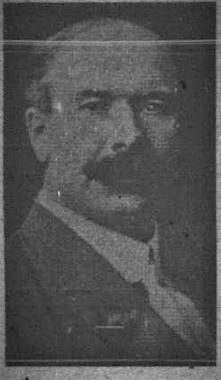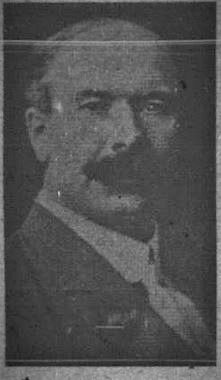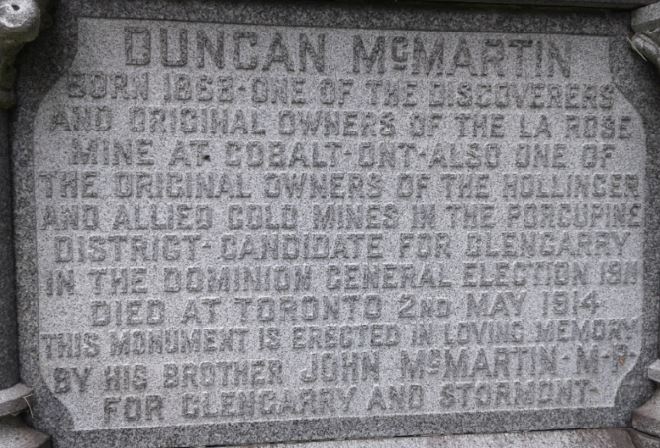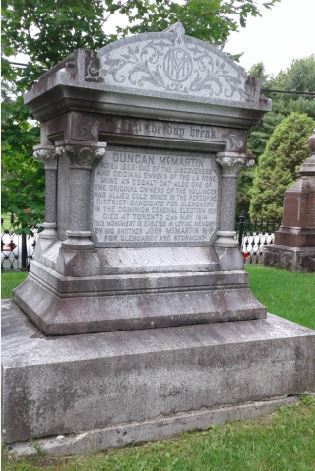Born a twin, Duncan shared his birthdays with brother Hugh McMartin, as youngest of the large brood of 11 children of Glengarry farmer and prospector Allan McMartin and his first wife, Catherine McDonald. This was a Scottish-Canadian family that spoke Scottish Gaelic within their tight knit Scottish community well into late 19th century.
Their ancestors had come to the New World from the Highlands of Scotland during early colonial times (1773,on the ship, HMS "Pearl" with McDonnell Party sailing from Fort William Scotland to New York, then up the Hudson River into the Mohawk River Valley). They settled as a community group there, on tenant lands of British Indian Agent, Sir William Johnson. New York was still a royal province at that time, dominated by the Dutch (in the south) and the Iroquois (Mohawk) Indians(northern areas). The emigrants had all left Scotland disillusioned, looking for a "new" beginning in New York on the American frontier. Their martial skills were used by the British in defending their New York territorial claims. These same families fought with the British against the Canadian French in the French/Indian wars and then, against New England's Yankee settlers in the American Revolution. These were the Crown "Loyalists", whose land and property was confiscated after the American Revolution by the American Patriots. The Scots then moved further North to found the first settlement of what was later British Ontario (Canada West).
While winters were long and harsh in Canada, summers were used by these settlers for farming and sheep ranching. Allan McMartin farmed on his Crown Land Grant, but also "timbered" in winter for extra cash income. In summer also he went out to "prospect" for what was known to be hidden mineral wealth in Canada's rocky soil. Allan's sons including Duncan, accompanied him, learning the skills. All the "boys" spent their lives uncovering the great Canadian deposits of silver,cobalt, copper, and gold. His sons were two "Johns"("Black Jack"and "Red Jack"), Angus, Hugh and Duncan- this was a dynasty of prospectors, mining engineers and mine developers.
In 1903 sons Duncan and "Red" John(for his red hair/beard) hit the stroke of good luck all prospectors dream of, first of rich silver deposits in Cobalt and then gold in Porcupine area. The story of the discovery of Canada's richest, deepest vein of gold--the Hollinger Mine is legendary. Briefly, while these two brothers were prospecting, they also had "day jobs" with the then westward expanding Canadian railroads. A member of one of their parties, Bennie Hollinger, once stumbled onto a large black rock with "sparkles". Excitement among prospectors surfaced quickly. The rock was assayed "quietly and secretly", by a small group of rail workers, investor and prospectors, including the two McMartin brothers. A claim was immediately filed for an expansive of area near where the stone found. The two McMartins quickly bought out other interests, including Hollinger's during the early mine development process. Only the name Hollinger Mine remained. The find changed the destiny of this family for generations. The minerock was highest grade goldore, and the McMartins became fabulously wealthy overnight. So out of the log cabin in Glengarry and into mansion in Montreal and then on to life in New York City. The life story of Duncan, his wife, Iva and his three children, Duncan Jr, Allan and daughter, Melba, was forever altered again in 1914, when hearty Duncan,accustomed to rugged outdoor life, caught a morning chill in Montreal;family records note he refused timely call to his medical doctor as he developed a cough, fever, etc. Very quickly Duncan died at his home of pneumonia. He was only 46 years old. He was buried, not in Montreal, but back in Glengarry among his family with his father and ancestors. A large monument was later erected in St. Andrews United Churchyard cemetery in Williamstown. It is a tribute to both father Allan McMartin and his youngest son, Duncan, erected by brother John McMartin.
Born a twin, Duncan shared his birthdays with brother Hugh McMartin, as youngest of the large brood of 11 children of Glengarry farmer and prospector Allan McMartin and his first wife, Catherine McDonald. This was a Scottish-Canadian family that spoke Scottish Gaelic within their tight knit Scottish community well into late 19th century.
Their ancestors had come to the New World from the Highlands of Scotland during early colonial times (1773,on the ship, HMS "Pearl" with McDonnell Party sailing from Fort William Scotland to New York, then up the Hudson River into the Mohawk River Valley). They settled as a community group there, on tenant lands of British Indian Agent, Sir William Johnson. New York was still a royal province at that time, dominated by the Dutch (in the south) and the Iroquois (Mohawk) Indians(northern areas). The emigrants had all left Scotland disillusioned, looking for a "new" beginning in New York on the American frontier. Their martial skills were used by the British in defending their New York territorial claims. These same families fought with the British against the Canadian French in the French/Indian wars and then, against New England's Yankee settlers in the American Revolution. These were the Crown "Loyalists", whose land and property was confiscated after the American Revolution by the American Patriots. The Scots then moved further North to found the first settlement of what was later British Ontario (Canada West).
While winters were long and harsh in Canada, summers were used by these settlers for farming and sheep ranching. Allan McMartin farmed on his Crown Land Grant, but also "timbered" in winter for extra cash income. In summer also he went out to "prospect" for what was known to be hidden mineral wealth in Canada's rocky soil. Allan's sons including Duncan, accompanied him, learning the skills. All the "boys" spent their lives uncovering the great Canadian deposits of silver,cobalt, copper, and gold. His sons were two "Johns"("Black Jack"and "Red Jack"), Angus, Hugh and Duncan- this was a dynasty of prospectors, mining engineers and mine developers.
In 1903 sons Duncan and "Red" John(for his red hair/beard) hit the stroke of good luck all prospectors dream of, first of rich silver deposits in Cobalt and then gold in Porcupine area. The story of the discovery of Canada's richest, deepest vein of gold--the Hollinger Mine is legendary. Briefly, while these two brothers were prospecting, they also had "day jobs" with the then westward expanding Canadian railroads. A member of one of their parties, Bennie Hollinger, once stumbled onto a large black rock with "sparkles". Excitement among prospectors surfaced quickly. The rock was assayed "quietly and secretly", by a small group of rail workers, investor and prospectors, including the two McMartin brothers. A claim was immediately filed for an expansive of area near where the stone found. The two McMartins quickly bought out other interests, including Hollinger's during the early mine development process. Only the name Hollinger Mine remained. The find changed the destiny of this family for generations. The minerock was highest grade goldore, and the McMartins became fabulously wealthy overnight. So out of the log cabin in Glengarry and into mansion in Montreal and then on to life in New York City. The life story of Duncan, his wife, Iva and his three children, Duncan Jr, Allan and daughter, Melba, was forever altered again in 1914, when hearty Duncan,accustomed to rugged outdoor life, caught a morning chill in Montreal;family records note he refused timely call to his medical doctor as he developed a cough, fever, etc. Very quickly Duncan died at his home of pneumonia. He was only 46 years old. He was buried, not in Montreal, but back in Glengarry among his family with his father and ancestors. A large monument was later erected in St. Andrews United Churchyard cemetery in Williamstown. It is a tribute to both father Allan McMartin and his youngest son, Duncan, erected by brother John McMartin.
Family Members
-
![]()
Helen Janet "Nellie" McMartin Archambault
1851–1941
-
John "Black Jack" McMartin
1853 – unknown
-
![]()
Angus Findley McMartin
1857–1924
-
![]()
John "Red Jack" McMartin
1858–1918
-
![]()
Mary Eveline McMartin Crimmins
1863–1937
-
![]()
Helen Ann "Ella" McMartin Phillips
1864–1961
-
Hugh McMartin
1868–1956
-
![]()
Janet McMartin
1872–1892
-
Alexander McMartin
1875–1875
Sponsored by Ancestry
Advertisement
Advertisement















